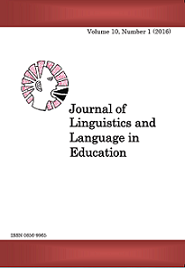DP-internal and V-external Agreement Patterns in Bantu: Re-statement of the Facts on Eastern Bantu Languages
Abstract
Based on the Minimalist Program, the present paper examines the phifeaturesand their specifications in Bantu DPs and IPs. Data are mainly
drawn from four Eastern Bantu languages: Kiswahili [G42], Kimakonde
[P23], Kisukuma [F21] and Ruhaya [JE22]. It is argued that Bantu
languages differ from Indo-European ones in that the head-noun
generally precedes all dependents, i.e., determiners and modifiers, in
most Bantu languages, and maintain the number feature. Secondly, the
agreement patterns in Bantu languages reveal a slightly different
structure from that found in Indo-European languages in relation in two
issues: (i) DP-internal agreement patterns, in which number is marked
on the head-noun, and to (ii) V-external agreement, which is controlled
by the semantic content of the head-noun as well as its number feature
(embedded in lexical nominal-heads). It is thus appropriate to maintain
NPs in Bantu, instead of shifting to DPs.
References
Carstens, V. (1993). On Nominal Morphology and DP Structure. In S. Mchombo (ed.),
Theoretical Aspects of Bantu Grammar. California: CSLI publications.
Carstens, V. (2008). NP in Bantu and Romance. In C. De Cat and K. Demuth (eds.), The
Bantu-Romance Connection: A Comparative Investigation of Verbal Agreement, NPs
and Information Structure. Amsterdam: John Benjamins.
Cinque, G. (2000). On Greenberg ' s Universal 20 and the Semitic DP. In L. Bruge (ed.),
University of Venice Working Papers in Linguistics, Dipartimento di Scienze del
Linguaggio, 10 (2): 45-61.
Chomsky, N. (1995). The Minimalist Program. Cambridge, MA: MIT Press.
Chomsky, N. (2001). Derivation by Phase. In M. Kenstowicz (ed.), Ken Hale: A Life in
Language. Cambridge, Massachussets: MIT Press.
Contini-Morava, E. (1994). Noun Classification in Swahili.
Publications of the Institute
for Advanced Technology in the Humanities, University of Virginia. Research
Reports, Second Series.
Dembetembe, N.C. (1988). The Structure and Function of the Noun Phrase in Shona. In
A. J. Pongweni and J. Thondhlana (eds.), LASU Conference Proceedings, Harare.
Edelstein, P., & C. Lijongwa. (2011). A Grammatical Sketch of Chindamba: A Bantu
Language (G52) of Tanzania. Köln: Rüdiger Köppe Verlag.
Gil, D. (2000). Syntactic Categories, Cross Linguistic Variation and Universal Grammar.
In P.M. Vogel and B. Comrie (eds.), Approaches to the Typology of Word Classes.
Berlin: Mouton.
Haegeman, L. (1994). Introduction to Government and Binding Theory. 2nd Edition.
Malden MA: Blackwell.
Harjula, L. (2004). The Ha Language of Tanzania: Grammar, Texts and Vocabulary.
Köln: Rüdiger Köppe Verlag.
Henderson, B. (2006). Multiple Agreement, Concord and Case Checking. In O. F.
Arasanyin and A. Permberson (eds.), Proceedings of the 36th ACAL.
Hyman, L., & K. Katamba. (1999). The Augment in Luganda: Syntax or Pragmatics? In
S. Mchombo (ed.), Theoretical Aspects of Bantu Grammar. StanfordCA: CSLI.
Iorio, D. (2011). The noun phrase in Kibembe (D54). Newcastle Working Papers in
Linguistics, Centre for Research in Linguistics and Language Sciences (CRiLLS)
: 46-65
Kihore, Y.M. (2004). Sarufi Miundo ya Kiswahili katika Karne ya Ishirini na Moja. In Y.
M. Kihore and A. R. Chuwa (eds.), Kiswahili katika Karne ya Ishirini na Moja. Dar es
Salaam: TUKI.
Leech, G., & J. Svartvik. (2002). Communicative Grammar of English. 3rd Edition.
London: Pearson Education Ltd.
Letsholo, R. (2004). Clausal and DP-internal Agreement in Ikalanga. Studies in African
Linguistics 33(1): 91-127.
LOT (2009). Atlasi ya Lugha za Tanzania. Dar es Salaam: University of Dar es Salaam.
Lusekelo, A. (2009a). The Structure of the Swahili Noun Phrase: Evidence from Fictional
Narratives. In W. Burger and M. Pienaar (eds.), Die tand van Die tyd: Opstelle
Opgedra aan Jac Conradie. Bloemfontein: Sun Press.
Lusekelo, A. (2009b). The Structure of the Nyakyusa Noun Phrase. Nordic Journal of
African Studies 38(4): 305-331.
Maho, J. (1999). A Comparative Study of Bantu Noun Classes. Götenburg: Acta
Universitatis Gothoburgensis.
Magashi, S. (2008.) Kisukuma Noun Phrase Structure. Unpublished M.A. Dissertation,
University of Dar es Salaam.
Mugane, J. (1998). Gikuyu NP Morphosyntax. In I. Maddieson and T. J. Hinnebusch
(eds.), Langauge History and Language Description in Africa. Trenton, NJ: African
World Press.
Mwihaki, A. (2007). A Minimalist Approach to Kiswahili Syntax. KISWAHILI: Journal of
the Institute of Kiswahili Research 70: 17-40.
Published
Issue
Section
License
Copyright © by Department of Foreign Languages and Linguistics, University of Dar es Salaam
All rights reserved. No part of this publication may be reproduced or transmitted in any form or by any means, electronic or mechanical, including photocopying, recording, or any information storage or retrieval system, without permission in writing from the publisher, except for short extracts in fair dealing, for research or private study, critical scholarly review or discourse with an acknowledgement.


